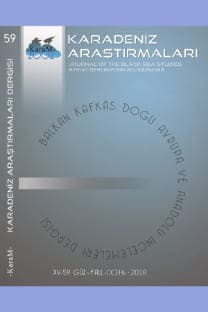Doğu Avrupa Türk Tarihinin Anahatları Altın Orda Öncesi Dönem
Türklerin anayurdunun İç Asya oluşu kuşkulu olmakla birlikte, iyi bilinen tarihle M.Ö. 8. yy'dan itibaren bu bölgeden Avrupa'ya doğru sürekli Türk göçleri olmuştur. Orta Asya'dan en kolay ve güvenli çıkış yolunun Hazar'ın kuzeyi olması sebebiyle, tarihte en fazla Türk göçü Doğu Avrupa'ya gerçekleşmiştir. Eskiçağ'daki Saka ve Sarmat güçlerini takiben, Ortaçağ boyunca da Hun, Oğur, Bulgar, Avar, Subar, Peçenek, Oğuz ve Kuman gibi çok önemli Türk toplulukları bu bölgeye yerleşmişler, ancak varlıklarını sürdüremeyerek kaybolup gitmişlerdir. Bu makalede, bölgenin Moğol istilasına uğradığı 1240 yılma kadarki dönem bir taslak halinde, tarihi sorunlara ağırlık verilerek ele alınmaktadır
Anahtar Kelimeler:
Doğu Avrupa Türkleri, Saka, Sarmat, Hun, Oğur, Bulgar, Avar, Subar, Peçenek, Oğuz, Kuman
Outlines of Turkic History in Eastern Europe before the Golden Horde Period
It is very sceptical to place Turkic homeland in Inner and Central Asia, but, anyway, several Turkic migrations took place from there to Eastern Europe from the 8th century B.C. on, as beginning of the known history. North of the Khazar Sea was the easiest and surest way to exit from Central Asia, thus majority of Turkic migrations targeted Eastern Europe. Following the ancient Scythian and Sarmatian westward movements, Turkic peoples like Huns, Oğurs, Bulgars, Avars, Suvars, Pechenegs, Oğuz and Cumans came to Europe during the Medieval, however all being fated to eventually ethnic annihilation. This article has an outline of the period before the Mongol invasion of Eastern Europe in 1240, and focuses upon problems of the concerning history, rather than events
Keywords:
Eastern Europe, Turks, Scythians, Sarmatians, Huns, Oğurs, Bulgars, Avars, Suvars, Pechenegs, Oğuz,
- ISSN: 2536-5126
- Yayın Aralığı: Yılda 4 Sayı
- Başlangıç: 2004
- Yayıncı: Osman Karatay
Sayıdaki Diğer Makaleler
Voyvodina Meselesi Üzerine Güncel Bir İnceleme I
Rize'nin Kahraman Savaş Çocukları
Doğu Avrupa Türk Tarihinin Anahatları Altın Orda Öncesi Dönem
Semra Alyılmaz: Borçalılı Bilim Adamı, Eğitimci, Şair Valeh Hacılar
Tatar Türklerinde Karşılaştırmalı Halk İnançları
Karadeniz'de Atma Türküler ve Atma Türkü Geleneği
